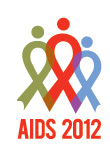 A new study conducted by Médecins Sans Frontières/Doctors Without Borders (MSF) indicates that while the governments of 23 key countries have made improvements to get antiretroviral (ARV) treatment to more people, implementation of innovative community-based strategies is lagging in some countries. The results of the study were reported by Sharonann Lynch, MSF’s HIV policy advisor, and her colleagues Tuesday, July 24, at the XIX International AIDS Conference (AIDS 2012) in Washington, DC.
A new study conducted by Médecins Sans Frontières/Doctors Without Borders (MSF) indicates that while the governments of 23 key countries have made improvements to get antiretroviral (ARV) treatment to more people, implementation of innovative community-based strategies is lagging in some countries. The results of the study were reported by Sharonann Lynch, MSF’s HIV policy advisor, and her colleagues Tuesday, July 24, at the XIX International AIDS Conference (AIDS 2012) in Washington, DC.
The study, which is also reviewed in a report available online, used 25 indicators in each of the 23 countries—MSF has HIV projects in 16—to show country progress. Indicators include coverage of ARV treatment and prevention of mother-to-child transmission (PMTCT), decentralized care out of hospitals and in the community, whether nurses instead of doctors can start patients on HIV and tuberculosis (TB) treatment—critical to relieving the burden on health systems and to get treatment further into communities—and how many health facilities in each country offer ARV therapy.
The data for the study were collected between March and June 2012.
Eleven of the 23 countries surveyed have reached ARV coverage—the ability to provide HIV treatment to those who require it medically—of 60 percent or more. Meanwhile, six countries are still reaching only a third of people in need.
The coverage rates of services for PMTCT are greater than 80 percent in six of the countries surveyed, but eight are still below 50 percent coverage. In five countries, PMTCT coverage is below 30 percent.
Only eight of the 20 countries for which data was available provided ARV treatment in 30 percent of more public-sector health facilities. Meanwhile, in countries like Lesotho, Malawi and South Africa, more than 60 percent of health facilities offer ARV treatment.
Of the 18 sub-Saharan African countries in the study, 11 allow nurses to start people living with HIV on ARV therapy, with Kenya, South Africa, Swaziland, Uganda, Zambia and Zimbabwe having changed their policies in the last two years to allow this. Conversely, Mozambique—with the highest HIV prevalence of the countries in the study—still does not allow nurses to initiate and manage ARV treatment. Additionally, only 14 of the 23 countries allow non-clinician lay workers to provide basic HIV services like prevention, testing and treatment adherence counseling.
The study authors also noted that while all countries in the survey had adopted World Health Organization-recommended (and better tolerated) ARVs, along with ARV therapy initiation at 350 CD4 cells (as opposed to the previous recommendation of 200), implementation in some countries is lagging due to funding shortfalls.
Also of concern is the finding that viral load monitoring—an essential tool for monitoring patients while on treatment—is widely available in only four countries.
“What we’re seeing is that governments are working to get better HIV medicines to their people, and to provide treatment closer to home so that more people can benefits,” said Lynch. “But there’s still a long way to go. More countries need to shift policies to allow nurses to start people on treatment, and other works to monitor patients’ treatment so treatment can be available in every clinic, in every village, in every country struggling with HIV."
Advertisement
Advertisement
Advertisement






Comments
Comments